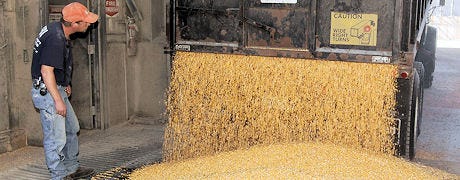
Through spring 2015, it appears any sort of rally in the grain markets must be demand driven.
Unfortunately, market analysts don't see a whole lot of potential to improve corn consumption. Without a misstep in the Southern Hemisphere’s corn crop, University of Illinois' Darrell Good puts rally potential for 2015 at 50 cents. Purdue Ag economist Chris Hurt puts corn’s rally potential in the range of 55 to 65 cents (if the market provides normal carry), and a 20- to 30-cent speculative rally.

Cheap corn will eventually bolster consumption. Unfortunately, experts agree it will be a slow process.
Taking the demand sectors one by one, Good notes domestic ethanol production doesn’t hold a lot of upside potential. Domestically, ethanol producers have been pushing against the blend wall (the saturation point for 10% ethanol blended into gasoline) for a couple years now. However, Good notes cheap corn means ethanol will be quite competitive with gasoline. He sees potential for ethanol exports to pick up moving into 2015.
“Rather than going down as USDA has projected, I see a modest increase in demand potential from the ethanol sector,” says Good.
Feed outlook
Eventually the feed sector will respond to this glut of corn. But, Good and Hurt say it won’t be anytime soon.
Good notes the broiler and dairy industries are expected to moderately increase numbers. As pork producers push past porcine epidemic diarrhea virus, the hog industry offers the best opportunity to boost production. High cattle prices are expected to eventually drive numbers higher. Good says this not expected in the near-term and no increases are expected through early 2015.
“The market just liquidated a lot of the cow herd,” Good adds. “Beef prices will dictate a response, but it will be slow.”
Export outlook
The U.S. wasn’t the only ag sector to have a big crop this year. Most countries in the northern hemisphere had bumper crops in 2014.
European countries recently put away a big wheat crop. It was a relatively low-quality crop, so much of it will end up in the feed market, Good notes. Plus, China harvested a sizeable corn crop.
For these reasons, Good says the exports market likely won’t be a source of increased demand.
“This year, exports have been relatively strong,” he notes. “It will be hard to maintain that level in coming years.”
All this adds up to a pretty dismal outlook for corn prices. Any increase in demand potential will come on very slowly. Even then, he doesn’t see that happening before January 2015. Some sort of supply disruption is necessary to push prices north, Good concludes.
Bearish on beans
The news isn’t much better for soybean demand.
Bryce Knorr, Farm Future’s senior market analyst, notes end-users had a tough time finding soybeans before harvest. August was definitely the time to clean the old-crop soybeans out of the bin.
That said, some 3.9 billion bushels are expected to flood the market this fall. An extremely tight stocks-to-use situation will give way to the loosest ratio in decades, Knorr adds.
“Global demand for soybeans continues to grow, but it won’t be enough to soak up this massive crop,” Knorr says.
China is expected to post a 7.5% growth in gross domestic product. The country’s continued growth has Knorr optimistic for soybean export opportunities.
Yet, hedge funds are taking record bearish positions on soybeans. Knorr says it’s primarily because ending stocks are expected to triple.
Long term, Hurt predicts soybean futures will be in the $9 range for the next six months to a year. Once the market takes the next four months to fully absorb how large this crop is, Hurt says any sort of rally discussion can begin. Of course, by early 2015, all eyes will be on South America.
- Flint is editor of Prairie Farmer a sister publication to Farm Futures.
About the Author(s)
You May Also Like




